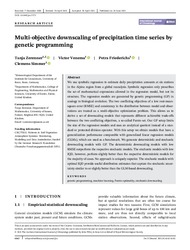Multi‐objective downscaling of precipitation time series by genetic programming
DOI: https://doi.org/10.1002/joc.7172
Persistent URL: http://resolver.sub.uni-goettingen.de/purl?gldocs-11858/9793
Persistent URL: http://resolver.sub.uni-goettingen.de/purl?gldocs-11858/9793
Zerenner, Tanja; Venema, Victor; Friederichs, Petra; Simmer, Clemens, 2021: Multi‐objective downscaling of precipitation time series by genetic programming. In: International Journal of Climatology, Band 41, 14: 6162 - 6182, DOI: 10.1002/joc.7172.
 |
Dokument öffnen: |
We use symbolic regression to estimate daily precipitation amounts at six stations in the Alpine region from a global reanalysis. Symbolic regression only prescribes the set of mathematical expressions allowed in the regression model, but not its structure. The regression models are generated by genetic programming (GP) in analogy to biological evolution. The two conflicting objectives of a low root‐mean‐square error (RMSE) and consistency in the distribution between model and observations are treated as a multi‐objective optimization problem. This allows us to derive a set of downscaling models that represents different achievable trade‐offs between the two conflicting objectives, a so‐called Pareto set. Our GP setup limits the size of the regression models and uses an analytical quotient instead of a standard or protected division operator. With this setup we obtain models that have a generalization performance comparable with generalized linear regression models (GLMs), which are used as a benchmark. We generate deterministic and stochastic downscaling models with GP. The deterministic downscaling models with low RMSE outperform the respective stochastic models. The stochastic models with low IQD, however, perform slightly better than the respective deterministic models for the majority of cases. No approach is uniquely superior. The stochastic models with optimal IQD provide useful distribution estimates that capture the stochastic uncertainty similar to or slightly better than the GLM‐based downscaling. We have fitted deterministic and stochastic empirical‐statistical downscaling models that represent different possible compromises between two conflicting objectives: (a) a low RMSE and (b) consistency in the distribution between downscaled series and reference observations. The graphic shows the skill of our downscaling models w.r.t. the two objectives (larger is better) for the station Sonnblick.
Statistik:
ZugriffsstatistikSammlung:
This is an open access article under the terms of the Creative Commons Attribution‐NonCommercial‐NoDerivs License, which permits use and distribution in any medium, provided the original work is properly cited, the use is non‐commercial and no modifications or adaptations are made.

